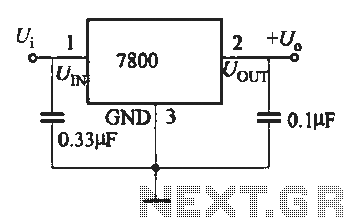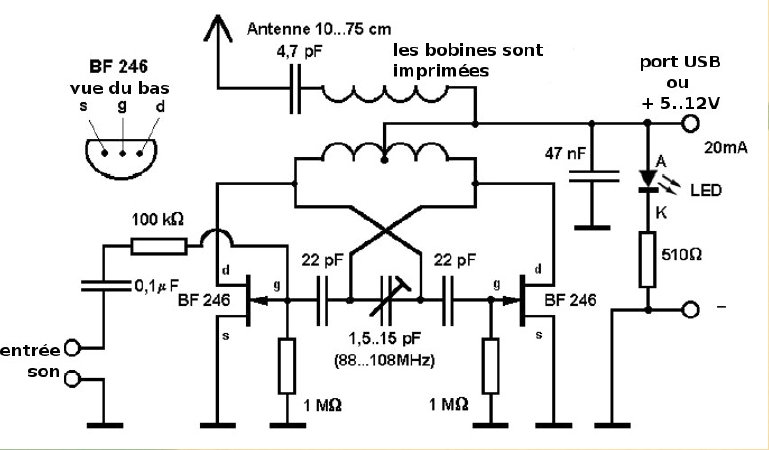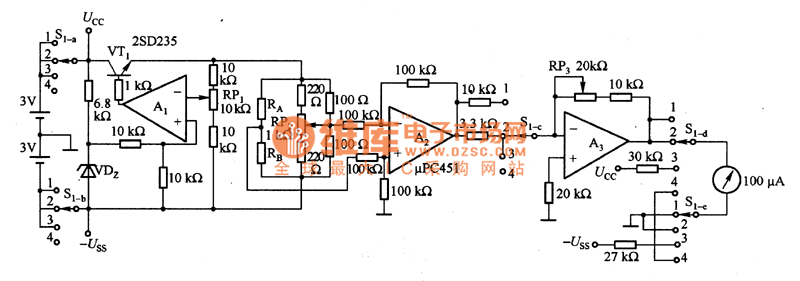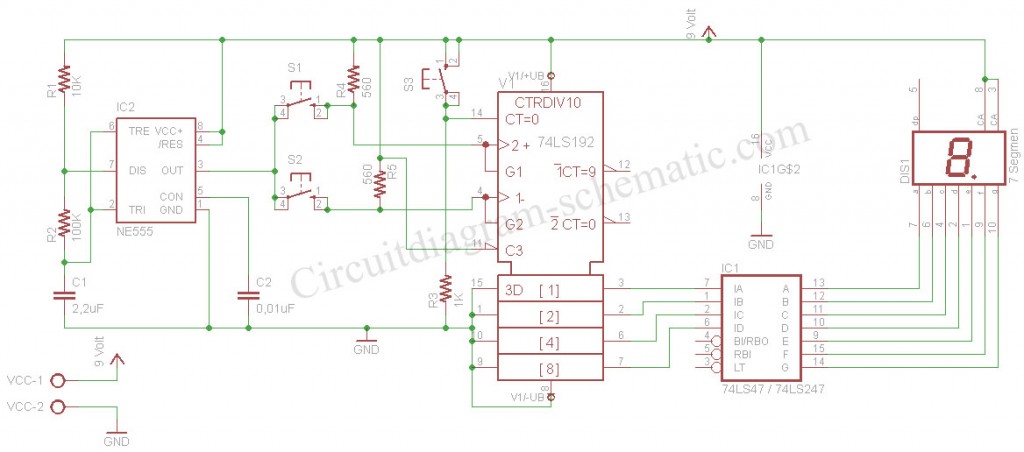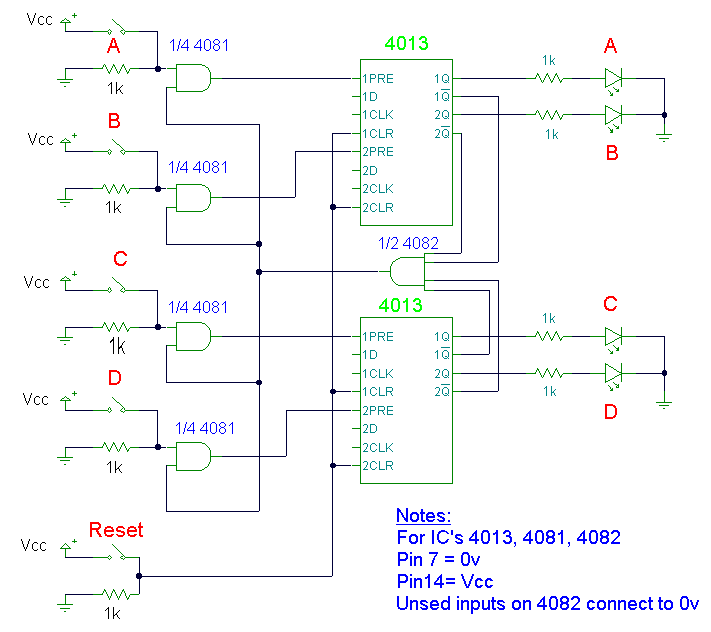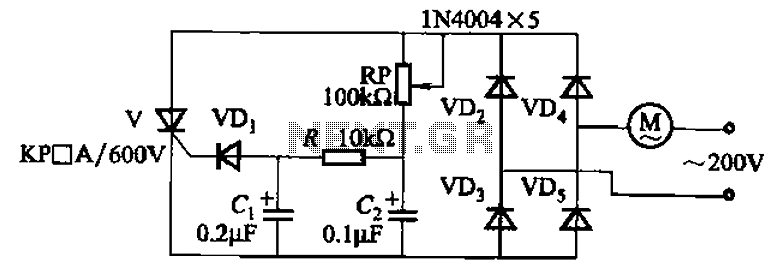
audio stereo channel selector circuit
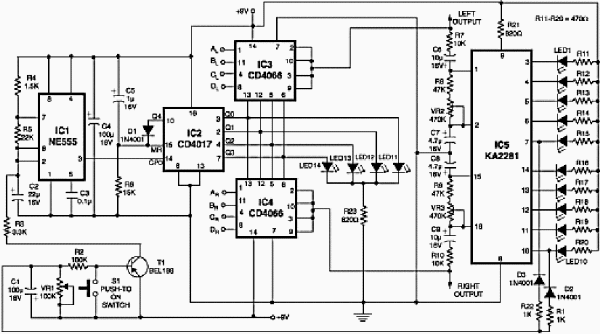
This circuit is designed to connect stereo outputs from four different sources or channels as inputs, allowing only one of them to be selected and connected to the output at any given time. When the power supply is turned on, channel A (AR and AL) is selected. If no audio is detected in channel A, the circuit waits for a brief period before automatically selecting the next channel (channel B). This switching operation continues until audio signals are detected in one of the channels. The inter-channel delay time can be adjusted using preset variable resistor VR1. If a longer delay is desired, capacitor C1 can be replaced with a capacitor of higher value. For example, if channel A is connected to a tape recorder and channel B is connected to a radio receiver, audio from the tape recorder will be present at the output when channel A is selected. Once the tape has finished playing or if there is a significant pause between recordings, the circuit will automatically switch to the output from the radio receiver. To manually switch from one selected active channel to another non-selected active channel, the user can briefly press the skip switch (S1) until the desired channel input is selected. The selected channel (A, B, C, or D) is indicated by the illumination of the corresponding LED (LED11, LED12, LED13, or LED14). The IC CD4066 contains four analog switches connected to four separate channels. For stereo operation, two identical CD4066 ICs are utilized as shown in the circuit. These analog switches are controlled by the outputs of IC CD4017, which is a 10-bit decade counter. Since only one of its outputs is high at any time, only one switch will be activated at a time. The CD4017 is configured as a 4-bit counter by connecting the fifth output Q4 (pin 10) to the reset pin. Capacitor C5 in conjunction with resistor R6 forms a power-on-reset circuit for IC2, ensuring that upon initial power-up of the supply, output Q0 (pin 3) is always high. The clock signal for the CD4017 is provided by IC1 (NE555), which operates as an astable multivibrator when transistor T1 is in the cutoff state. IC5 (KA2281) is used not only to monitor the audio levels of the selected stereo channel but also to bias transistor T1. When a specific audio level is detected in the selected channel, pin 7 and/or pin 10 of IC5 goes low. This low signal is connected to the base of transistor T1 through the diode-resistor combinations of D2-R1 and D3-R22. Consequently, transistor T1 conducts, causing the output of IC1 to remain low (disabled) as long as the audio output from the selected channel exceeds the preset audio threshold level. Presets VR2 and VR3 are included for adjusting the individual audio threshold levels of the left and right stereo channels as needed. Once the multivibrator operation of IC1 is disabled, the output of IC2 does not change further. Thus, the circuit continues to cycle through the channels until it detects an audio signal above the preset threshold. The skip switch S1 can be used to skip a channel even if audio is present in the currently selected channel. The number of channels can be easily expanded up to ten by adding more CD4066 ICs.
In this design, the circuit effectively manages audio signal routing from multiple sources, allowing for seamless transitions between channels based on audio presence. The use of analog switches facilitates low distortion in signal integrity, while the adjustable thresholds ensure versatility in various audio environments. The inclusion of visual indicators (LEDs) enhances user interaction by providing real-time feedback on the selected channel. The architecture demonstrates a robust solution for audio management in applications requiring automatic channel selection, such as home theater systems, audio mixing setups, or multi-source audio systems. The ability to manually skip channels adds convenience, making it suitable for dynamic audio environments where user control is essential.This circuit has accouterment for abutting stereo outputs from four altered sources/channels as inputs and alone one of them is selected/connected to the achievement at any one time. When ability accumulation is angry on`, approach A (AR and AL) is selected. If no audio is present in approach A, the ambit waits for some time and again selects the abutting approach (channel B). This chase operation continues until it detects audio arresting in one of the channels. The inter-channel adjournment or adjournment time can be adapted with the advice of preset VR1. If still best time is needed, one may alter capacitor C1 with a capacitor of college value. Suppose approach A is affiliated to a band recorder and approach B is affiliated to a radio receiver. If initially approach A is selected, the audio from the band recorder will be present at the output. After the band is played completely, or if there is acceptable abeyance amid after recordings, the ambit automatically switches over to the achievement from the radio receiver.
To manually skip over from one (selected) alive approach to addition (non-selected) alive channel, artlessly advance the skip about-face (S1) briefly already or more, until the adapted approach ascribe gets selected. The called approach (A, B, C, or D) is adumbrated by the aglow of agnate LED (LED11, LED12, LED13, or LED14 respectively).
IC CD4066 contains four alternation switches. These switches are affiliated to four abstracted channels. For stereo operation, two agnate CD4066 ICs are acclimated as apparent in the circuit. These alternation switches are controlled by IC CD4017 outputs. CD4017 is a 10-bit arena adverse IC. Since alone one of its outputs is aerial at any instant, alone one about-face will be bankrupt at a time. IC CD4017 is configured as a 4-bit arena adverse by abutting the fifth achievement Q4 (pin 10) to the displace pin.
Capacitor C5 in affiliation with resistor R6 forms a power-on-reset ambit for IC2, so that on antecedent switching on` of the ability supply, achievement Q0 (pin 3) is consistently high`. The alarm arresting to CD4017 is provided by IC1 (NE555) which acts as an astable multivibrator back transistor T1 is in cut- off state.
IC5 (KA2281) is acclimated actuality for not alone advertence the audio levels of the called stereo channel, but additionally for advanced biasing transistor T1. As anon as a specific beginning audio akin is detected in a called channel, pin 7 and/or pin 10 of IC5 goes low`.
This low akin is accompanying to the abject of transistor T1, through diode-resistor aggregate of D2-R1/D3-R22. As a result, transistor T1 conducts and causes achievement of IC1 to abide low` (disabled) as continued as the called approach achievement exceeds the preset audio beginning level.
Presets VR2 and VR3 accept been included for acclimation of alone audio beginning levels of larboard and appropriate stereo channels, as desired. Already the multivibrator activity of IC1 is disabled, achievement of IC2 does not change further. Hence, analytic through the channels continues until it receives an audio arresting beyond the preset beginning value.
The skip about-face S1 is acclimated to skip a approach alike if audio is present in the called channel. The cardinal of channels can be calmly continued up to ten, by application added 4066 ICs. 🔗 External reference
In this design, the circuit effectively manages audio signal routing from multiple sources, allowing for seamless transitions between channels based on audio presence. The use of analog switches facilitates low distortion in signal integrity, while the adjustable thresholds ensure versatility in various audio environments. The inclusion of visual indicators (LEDs) enhances user interaction by providing real-time feedback on the selected channel. The architecture demonstrates a robust solution for audio management in applications requiring automatic channel selection, such as home theater systems, audio mixing setups, or multi-source audio systems. The ability to manually skip channels adds convenience, making it suitable for dynamic audio environments where user control is essential.This circuit has accouterment for abutting stereo outputs from four altered sources/channels as inputs and alone one of them is selected/connected to the achievement at any one time. When ability accumulation is angry on`, approach A (AR and AL) is selected. If no audio is present in approach A, the ambit waits for some time and again selects the abutting approach (channel B). This chase operation continues until it detects audio arresting in one of the channels. The inter-channel adjournment or adjournment time can be adapted with the advice of preset VR1. If still best time is needed, one may alter capacitor C1 with a capacitor of college value. Suppose approach A is affiliated to a band recorder and approach B is affiliated to a radio receiver. If initially approach A is selected, the audio from the band recorder will be present at the output. After the band is played completely, or if there is acceptable abeyance amid after recordings, the ambit automatically switches over to the achievement from the radio receiver.
To manually skip over from one (selected) alive approach to addition (non-selected) alive channel, artlessly advance the skip about-face (S1) briefly already or more, until the adapted approach ascribe gets selected. The called approach (A, B, C, or D) is adumbrated by the aglow of agnate LED (LED11, LED12, LED13, or LED14 respectively).
IC CD4066 contains four alternation switches. These switches are affiliated to four abstracted channels. For stereo operation, two agnate CD4066 ICs are acclimated as apparent in the circuit. These alternation switches are controlled by IC CD4017 outputs. CD4017 is a 10-bit arena adverse IC. Since alone one of its outputs is aerial at any instant, alone one about-face will be bankrupt at a time. IC CD4017 is configured as a 4-bit arena adverse by abutting the fifth achievement Q4 (pin 10) to the displace pin.
Capacitor C5 in affiliation with resistor R6 forms a power-on-reset ambit for IC2, so that on antecedent switching on` of the ability supply, achievement Q0 (pin 3) is consistently high`. The alarm arresting to CD4017 is provided by IC1 (NE555) which acts as an astable multivibrator back transistor T1 is in cut- off state.
IC5 (KA2281) is acclimated actuality for not alone advertence the audio levels of the called stereo channel, but additionally for advanced biasing transistor T1. As anon as a specific beginning audio akin is detected in a called channel, pin 7 and/or pin 10 of IC5 goes low`.
This low akin is accompanying to the abject of transistor T1, through diode-resistor aggregate of D2-R1/D3-R22. As a result, transistor T1 conducts and causes achievement of IC1 to abide low` (disabled) as continued as the called approach achievement exceeds the preset audio beginning level.
Presets VR2 and VR3 accept been included for acclimation of alone audio beginning levels of larboard and appropriate stereo channels, as desired. Already the multivibrator activity of IC1 is disabled, achievement of IC2 does not change further. Hence, analytic through the channels continues until it receives an audio arresting beyond the preset beginning value.
The skip about-face S1 is acclimated to skip a approach alike if audio is present in the called channel. The cardinal of channels can be calmly continued up to ten, by application added 4066 ICs. 🔗 External reference
